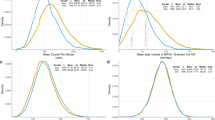Abstract
Purpose
The aims of this study were to (i) examine gender differences in physical inactivity in countries with different levels of Human Development Index (HDI); and (ii) assess whether small changes in the prevalence of inactivity in women could achieve the World Health Organization’s (WHO) global inactivity target.
Methods
Data on inactivity were extracted for 142 countries for the year 2010 from the WHO Data Repository. Data for HDI were obtained for the year 2010 from the United Nations Development Program. Absolute and relative gender differences were calculated for countries according to four HDI categories. The potential effects of increasing women’s activity levels on achievement of the WHO physical inactivity target were computed.
Results
Overall inactivity prevalence was higher in women (27%) than in men (20%). Women were more inactive than men in all except eight countries. Absolute gender differences [median 7.5% (range −10.1 to 33.2)] did not vary by HDI category, but there was a small negative correlation between relative gender difference in inactivity and HDI (rho −0.19; p = 0.02), which was mostly influenced by three outlier countries with low HDI. A decrease in inactivity levels of 4.8% points among women across the world would achieve the WHO target of reducing global levels of inactivity by 10%.
Conclusion
Gender differences in the prevalence of physical inactivity were highly variable, both within and across categories of HDI. Interventions which result in small changes in inactivity prevalence in women would achieve the 2025 WHO global target for inactivity, without any change to the prevalence in men.




Similar content being viewed by others
References
Lee IM, Shiroma EJ, Lobelo F, Puska P, Blair SN, Katzmarzyk PT. Effect of physical inactivity on major non-communicable diseases worldwide: an analysis of burden of disease and life expectancy. Lancet. 2012;380(9838):219–29.
WHO. Global action plan for the prevention and control of NCDs, 2013–2020. Geneva: World Health Organization; 2013.
WHO. Global status report on noncommunicable diseases, 2014. World Health Organization, Geneva; 2014. http://apps.who.int/iris/bitstream/10665/148114/1/9789241564854_eng.pdf?ua=1. Accessed 19 Jan 2017.
Dumith SC, Hallal PC, Reis RS, Kohl HW 3rd. Worldwide prevalence of physical inactivity and its association with human development index in 76 countries. Prev Med. 2011;53(1–2):24–8.
Sallis JF, Bull F, Guthold R, Heath GW, Inoue S, Kelly P, Oyeyemi AL, Perez LG, Richards J, Hallal PC. Lancet physical activity series 2 executive committee. Progress in physical activity over the Olympic quadrennium. Lancet. 2016;388(10051):1325–36.
Brown WJ, Mielke GI, Kolbe-Alexander TL. Gender equality in sport for improved public health. Lancet. 2016;388(10051):1257–8.
WHO. Global health observatory. Insufficient physical activity. World Health Organization, Geneva; 2015. http://apps.who.int/gho/data/node.main.A892?lang=en. Accessed 19 Jan 2017.
WHO. Global recommendations on physical activity for health. Geneva: World Health Organization; 2010.
UNDP. Human development reports. United Nations development programme; 2015. http://hdr.undp.org/en/content/human-development-index-hdi. Accessed 19 Jan 2017.
WHO. STEPwise approach to chronic disease risk factor surveillance. World Health Organization, STEPS survey report Nepal; 2013. http://www.who.int/chp/steps/2012-13_Nepal_STEPS_Report.pdf?ua=1. Accessed 19 Jan 2017.
WHO. STEPwise approach to chronic disease risk factor surveillance. World Health Organization, STEPS survey report Indonesia; 2006. http://www.who.int/chp/steps/STEPS_Report_Indonesia_Depok_2006.pdf?ua=1. Accessed 19 Jan 2017.
Guthold R, Louazani SA, Riley LM, Cowan MJ, Bovet P, Damasceno A, Sambo BH, Tesfaye F, Armstrong TP. Physical activity in 22 African countries: results from the World Health Organization STEPwise approach to chronic disease risk factor surveillance. Am J Prev Med. 2011;41(1):52–60.
WHO. STEPwise approach to chronic disease risk factor surveillance. World Health Organization, STEPS survey report Kuwait; 2014. http://www.who.int/chp/steps/Kuwait_2014_STEPS_Report.pdf?ua=1. Accessed 19 Jan 2017.
Amin TT, Al Khoudair AS, Al Harbi MA, Al Ali AR. Leisure time physical activity in Saudi Arabia: prevalence, pattern and determining factors. Asian Pac J Cancer Prev. 2012;13(1):351–60.
Armstrong T, Bull F. Development of the World Health Organization global physical activity questionnaire (GPAQ). J Public Health. 2006;14:66–70.
Bull FC, et al. Global physical activity questionnaire (GPAQ): nine country reliability and validity study. J Phys Act Health. 2009;6:790–804.
Craig CL, et al. International physical activity questionnaire: 12-country reliability and validity. Med Sci Sports Exerc. 2003;35:1381–95.
International Olympic Committee. IOC factsheet women in the Olympic movement—updated January 2016. http://www.olympic.org/Documents/Reference_documents_Factsheets/Women_in_Olympic_Movement.pdf. Accessed 19 Jan 2017.
Sport England. This girl can. https://www.sportengland.org/our-work/women/this-girl-can/. Accessed 19 Jan 2017.
Ministry of Information and Communications. Kau Mai Tonga campaign wins WHO Health Islands recognition award. http://www.mic.gov.to/health-a-ncds/ncds/4493-kau-mai-tonga-ke-tau-netipolocampaign-wins-who-health-islands-recognitionaward. Accessed 19 Jan 2017.
Author information
Authors and Affiliations
Corresponding author
Ethics declarations
Conflicts of interest
Gregore I. Mielke, Inacio Crochemore M. da Silva, Tracy L. Kolbe-Alexander and Wendy J. Brown declare that they have no conflicts of interest relevant to the content of this paper. The authors alone are responsible for the views expressed in this publication and they do not represent the decisions, policy or views of the World Health Organization.
Funding
No specific financial support was received for the conduct of this study or for the preparation of the manuscript. Gregore Mielke and Tracy Kolbe-Alexander were funded by a strategic grant from the University of Queensland which supported research fellows in the Centre for Research on Exercise, Physical Activity and Health at The University of Queensland.
Rights and permissions
About this article
Cite this article
Mielke, G.I., da Silva, I.C.M., Kolbe-Alexander, T.L. et al. Shifting the Physical Inactivity Curve Worldwide by Closing the Gender Gap. Sports Med 48, 481–489 (2018). https://doi.org/10.1007/s40279-017-0754-7
Published:
Issue Date:
DOI: https://doi.org/10.1007/s40279-017-0754-7




